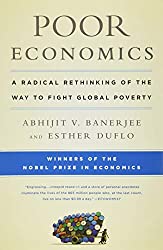
Rating: 8.4/10.
Book Review: Poor Economics: A Radical Rethinking of the Way to Fight Global Poverty by Abhijit V. Banerjee and Esther Duflo
We have a lot of stereotypes about poor people, and these stereotypes influence our foreign aid and intervention policies. The problem is that these preconceptions are often inaccurate. This book, by two MIT economics professors, surveys decades of research (mostly from India, Kenya, and Indonesia) about the day-to-day realities of poor people’s lives (those living on $1 a day or so). Many economic models are appealing yet wrong as they do not reflect reality, so it’s important to look at actual data (ideally, randomized control trials).
A common assumption about poor people is they’re hungry and don’t have enough food. This is usually not the case, as studies found that they don’t spend their money in a way that optimizes their nutrient intake, instead they care about the taste of their food as well. Often, they spend on non-essential entertainment (like a radio or a wedding ceremony) despite not having enough food to eat.
For healthcare, poor people spend a decent amount for treatment but very little on prevention, even though the latter is more cost-effective. They do understand the benefits when asked, but don’t like to spend their money on healthcare until it’s necessary, thus an effective intervention strategy is to give preventative medicine for free (eg: vaccines and malaria nets), or even pay people to get them.
In education, there is often a belief that education only has benefits after a lot of it is completed (at least high school), so there is a tendency to pool together resources to send only the most promising child in the family to school. However, the reality is every year of schooling increases lifetime income, with diminishing returns, so it is better to send everyone to a few years of school.
Contraceptives alone don’t tend to decrease birth rates because women are pressured by their families and society to have lots of children. Families use children as a form of insurance during old age when there is no government pension plan. When women gain more money and power, birth rates decrease since women usually want fewer children than their husbands.
The poor are subject to a degree of risk on a daily basis that dwarfs the risk we are used to, like a theft that leaves a family on a spiral to poverty. They help each other out when it’s feasible, but not for catastrophic medical expenses. Attempts to sell them insurance haven’t panned out because of natural optimism that bad things won’t happen, as well as distrust that the insurance company would find some technicality to avoid paying out.
Microfinance (small loans to the poor) have become trendy, but they are challenging to administer on a large scale because of the difficulty of vetting people without records (requires someone that knows them personally), and the difficulty of getting your money back. Thus loans to the poor usually have very high interest rates to make it worthwhile to the bank. The rigid payment schedule is not really suitable for risky businesses that might fail.
When it comes to saving, the poor want to save, but often fall to short-term temptations, so the money is not there when it is needed. Thus they often resort to unnatural forms of forced saving strategies, like buying fertilizer immediately after the harvest and months before it’s actually needed, and building a house a few bricks at a time instead of all at once.
Another common stereotype is that poor people are eager, entrepreneurs, ready to start a whole industry if they were given the chance. But in reality, these are small scale ventures that make very little money, far below minimum wage. They do it because the economy has failed at providing them with normal employment, and they’d be better off working a regular job in a factory or government with a predictable salary.
We are often pessimistic about political institutions in developing countries, as they seem too broken to be worth fixing. However, even imperfect interventions can have a noticeable outcome, like letting officials know they will be audited, and reminding people to vote on policies instead of along ethnic lines. Thus there is a case for optimism in fixing political institutions.
Overall, my main takeaway from this book is that poor people are in many ways similar to ourselves in first-world countries. They procrastinate on things that have an abstract benefit in the distant future like preventative medicine and healthy nutrition, they avoid thinking about large risks, they find it hard to save for the future, etc. The proposed interventions are not large transfers of wealth, but more like small nudges and incentives to get them to do the right thing.



